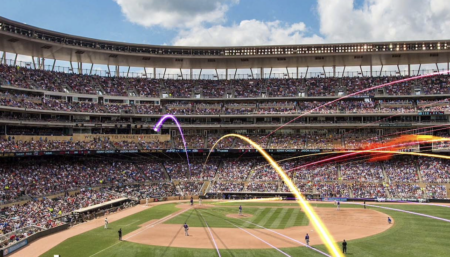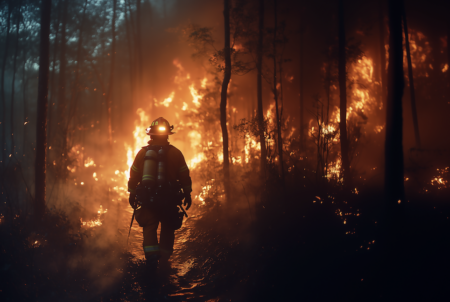On the cover of the latest issue of Stadia readers will have noticed renderings of the Banc of California Stadium, set to be the new home of Los Angeles FC when it opens in 2018. Situated in downtown LA, California, the 22,000-seat venue boasts a striking design, and the club also recently announced that the stadium will feature a safe-standing section. Stadia spoke with Alex Phi, lead designer at Gensler Sports, about the challenges of the project, and how the latest technologies were applied to the architectural process.
Tell us about one of the most challenging aspects of the stadium design and how you addressed it
Banc of California Stadium will be the first, new open-air stadium in Los Angeles since 1962. Set to debut in 2018, the new home of LAFC will accommodate up to 22,000 fans. The 190,000ft² ETFE roof canopy is one of the most complex forms that Gensler Sports has developed for the project. It is designed to minimize glare and heat on fans while simultaneously allowing enough sunlight in for grass growth on the pitch.
Beyond functional elements, this angel wing-inspired roof canopy is a character-defining feature for the project. The fluid canopy, structure and the complex ETFE panel system were designed using scripting software and close collaboration with our engineering and contractor partners. The resulting form is a dynamic unifying element, navigating all sections of the stadium seating bowl.
What do you feel are the venue’s strongest characteristics?
In early meetings with the club, LAFC made it clear that a world-class game-day experience would drive the design of Banc of California Stadium. We listened, crafting an intimate and intense match experience that will bring fans closer to the game than is typical in the MLS. From designing stadium seating at 34° to having our closest seats to the pitch at only 12ft away from the touchline, the stadium is designed to enhance this experience for fans.
Which elements of the stadium design are you most proud of?
While I’m excited about the roof canopy, I am equally proud of the supporters’ section. As the first stadium with safe standing on the West Coast and the first stadium in North America with safe standing rail seats, the Banc of California Stadium will provide the opportunity for supporters to stand shoulder-to-shoulder, creating an electrifying atmosphere on matchdays.
LAFC took a proactive and grass-roots approach with their supporters, engaging them in early brainstorming about everything from the club brand to the venue design. We embraced this open collaboration, leading town hall meetings and visioning sessions at our Los Angeles office with LAFC and supporter representatives to shape the design of ‘their’ stadium. It was in these sessions that the supporters championed the idea of safe standing for their section of Banc of California Stadium.
We worked with LAFC to verify the feasibility of this and determined that it was a win-win opportunity. We worked closely with LAFC ownership to incorporate global best practices into the safe-standing section, and we’re incredibly proud to have created the most supporter-forward environment in MLS.
What do you feel makes this stadium stand out from similar MLS venues that might be in the pipeline?
During the design process, LAFC’s owners stressed that, to be successful, this team and venue must be “of Los Angeles and for Los Angeles.” As the new MLS team in town, LAFC understood that capturing the ethos and authenticity of this city would resonate with future fans and be critical to challenging the market.
The stadium reflects these values, celebrating the city based on its proximity to Downtown, the diversity of program inside, and the unique experiences that will be offered on and off gameday. This design embraces and strengthens the LAFC brand, tying into the rich heritage of Los Angeles, one of the largest and most diverse markets in the world.
And it’s been an amazing experience to develop a new home for the new team in the fastest growing professional sport in America. This is more than a stadium. The Banc of California Stadium will be a sports destination that people will go out of their way to experience.
What role did VR/AR play in the design of the stadium?
As VR is quickly gaining popularity in many design industries, Gensler is analyzing how it affects every step of the design process, from conception to delivery, in terms of its effects on design.
On the storytelling front, we are working hard to provide the opportunity to get this in the hands of our clients, the sports teams. This will allow them to use this technology to sell sponsorship ideas, create branded opportunities, recruit players and coaches, and convey event configurations which becomes vital for ROI.
LAFC saw the value of VR from the onset, and has been a strong advocate and collaborative partner in how we use these design technologies to study and realize critical elements of this stadium.
How did the use of these technologies alter the process of designing a state-of-the-art stadium? What advantages did it bring?
Historically, architectural design was a very linear process when it comes to painting a story through floorplans, sections and renderings. With the use of VR/AR technology we can bring the design to life for our clients and fans, helping them to more easily see what we as designers are thinking. This is particularly critical when it comes to stakeholder feedback and approval during design. Stakeholder reviews are far more robust with these technologies, as decision makers can immerse themselves in the stadium and the experience to gain a more complete understanding of the design direction, accelerating the approval process.
Does the use of VR/AR have any limitations – and if so, do you feel these will be overcome as the technology advances?
Current limitations are really with the hardware. Gensler’s roadmap for VR/AR looks beyond the limitations of the current technology and specifically at the blue-sky nature of what reality offers us. Just like true reality, virtual and augmented reality technologies have their own version of every opportunity.
What did using VR/AR enable you, as designers, to model that you would not otherwise have been able to?
Unlike many teams we work with, LAFC is a new franchise with no preexisting history. We worked with the team to craft a vision for the design that helped to inform the character of the club and the brand.
Through VR, we have been able to leverage our visuals to craft unique experiences within this new brand to sell not only the design of spaces but also to convey the feeling of circulating through key sequences of the stadium. Using sound, video and interactive moments, we can give clients, partners and fans a realistic taste of the gameday experience, long before opening day. Fans have an unprecedented opportunity to engage this brand experience through VR.
Do you think this technology will be a mainstay of stadium design in the future?
Absolutely! At Gensler Sports, our focus goes beyond just designing spaces, but on creating experiences. Technology already plays a critical role in the gameday experience, from buying your tickets online and visualizing your seats to remotely ordering food or posting memories on social media while at the event. VR technology is unlocking opportunities to conceive, curate and communicate those experiences to our clients and to the end users – the fans – during the design process.
Tools like this help us to test fit the experience in a way far more compelling than rendered images could ever achieve, and will continue to influence how the best design ideas find their way into the final project and end-user experience.
August 16, 2017




